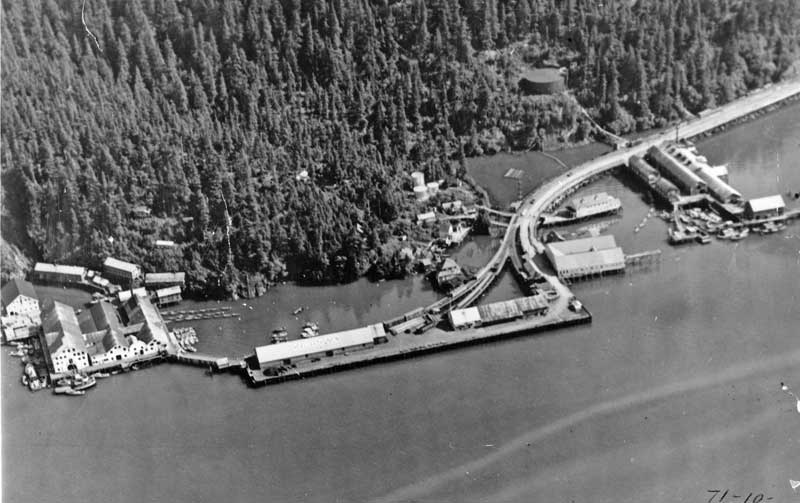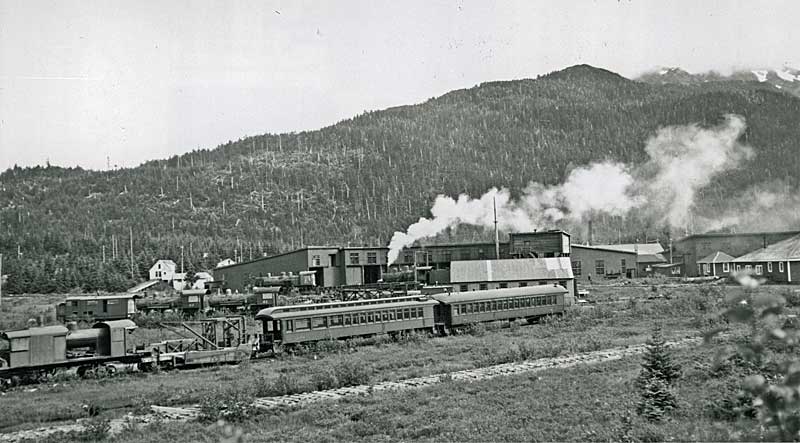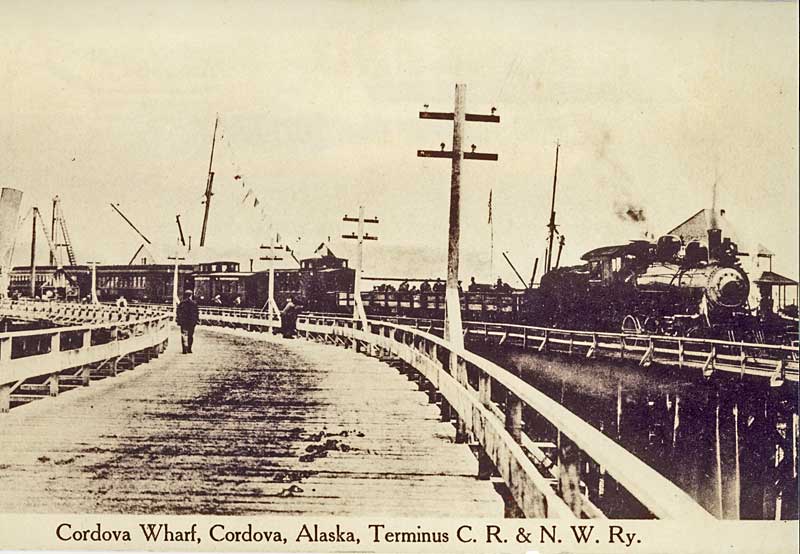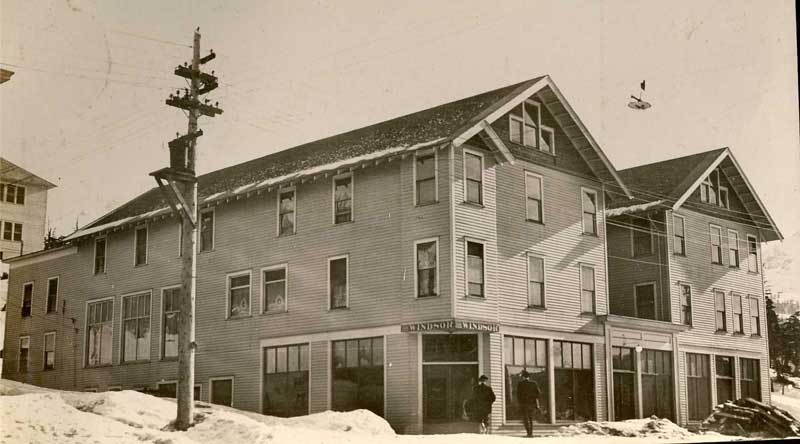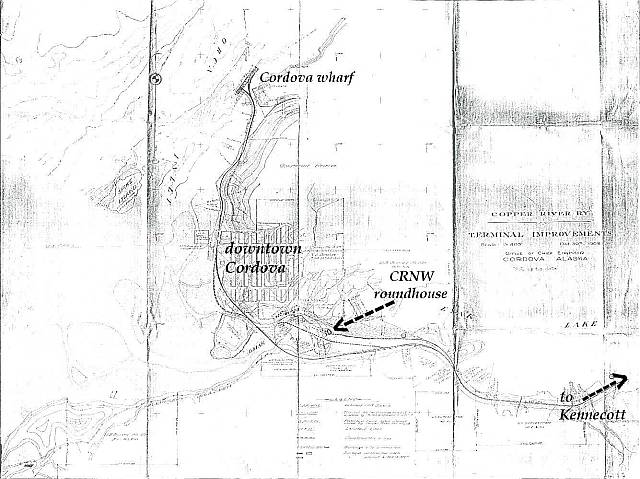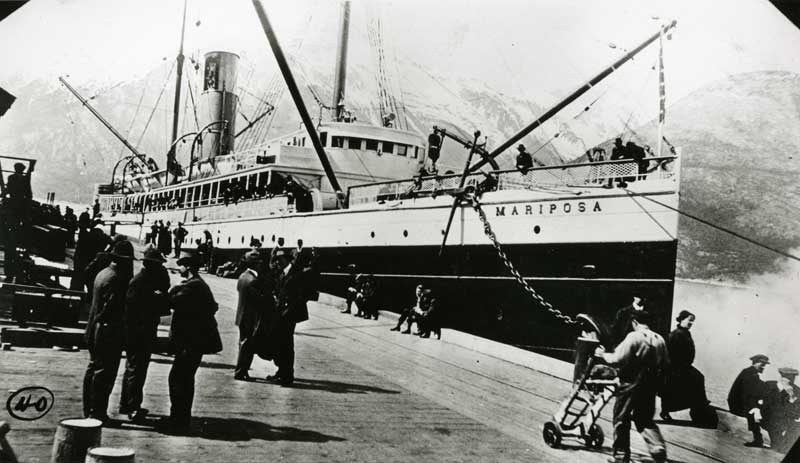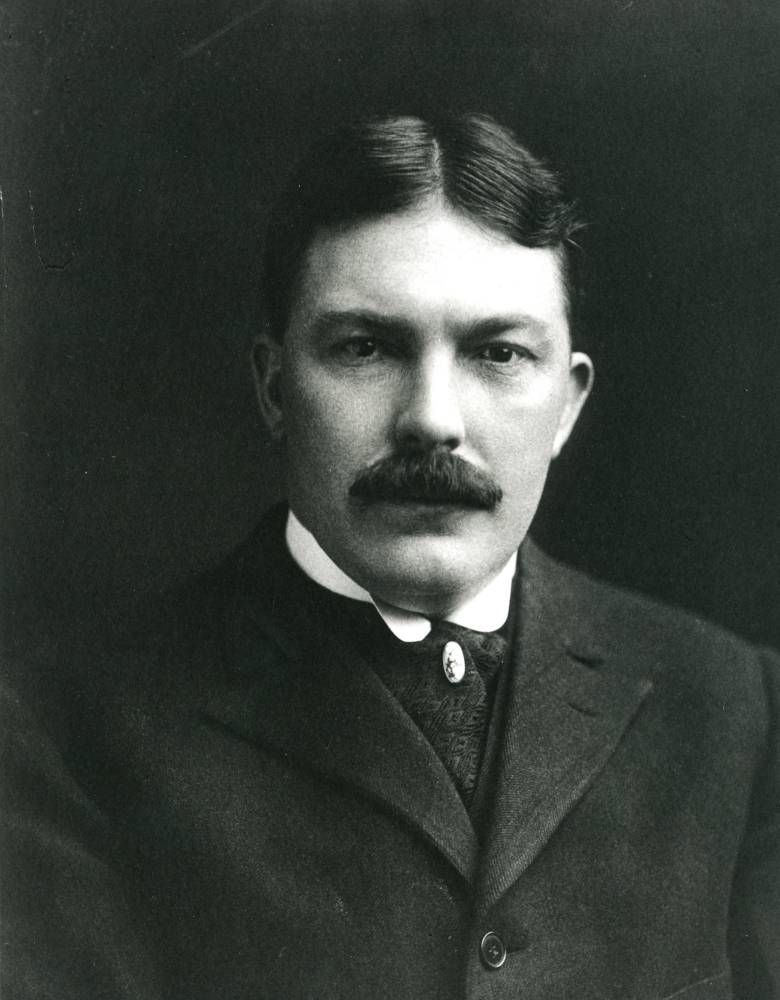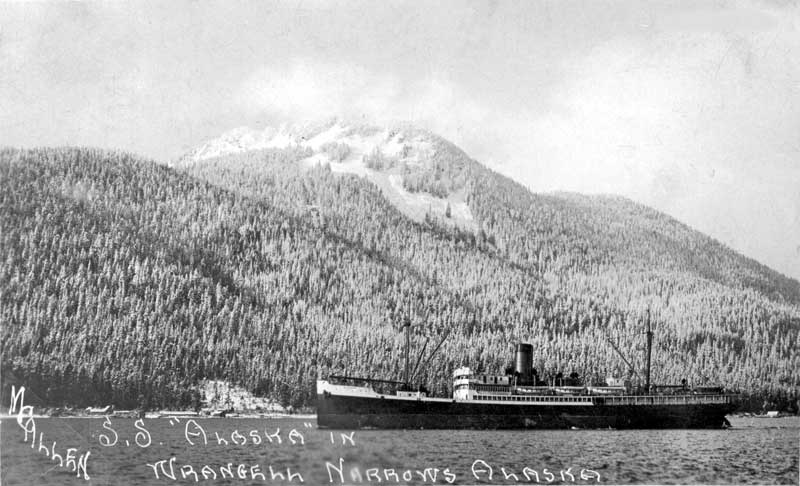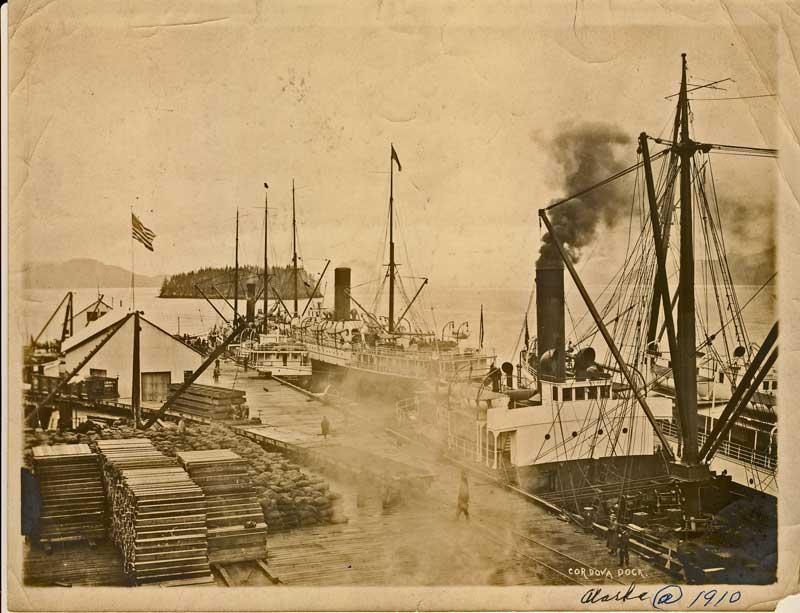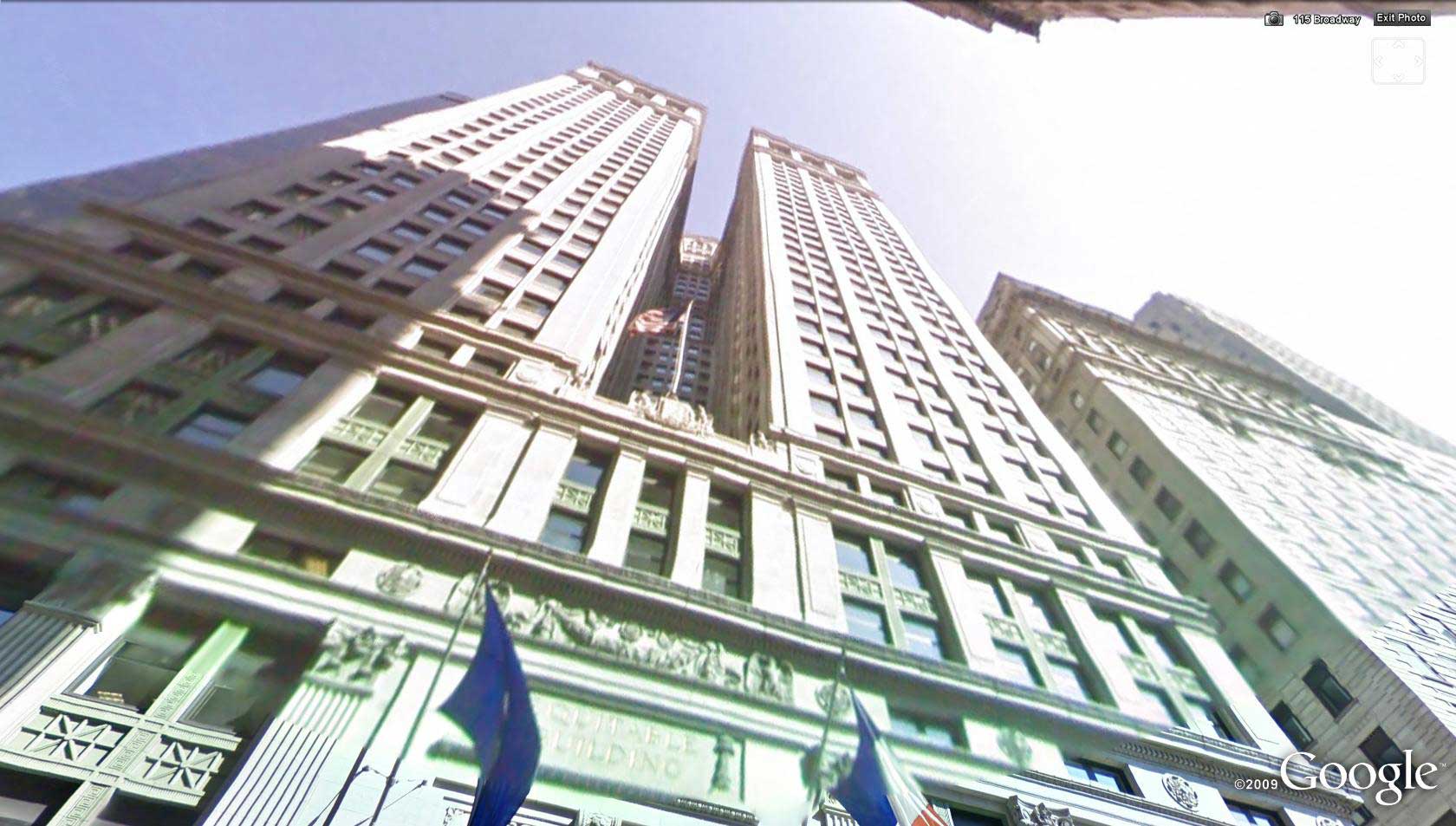Chapters from the historic novel "Legacy of the Chief," by Ronald Simpson, and other items mostly related to the historic background of the Ahtnas in the context of Kennecott Copper & its Copper River & Northwestern Railway.
04 November 2010
Ch 11, Pt 1: "Mary Storms into Alaska"
Ch 10, Pt 5: "Abercrombie Rapids Landing"
Abercrombie Rapids Landing: conclusion Above and below: Constructing a snowshed --John R. Van Cleve Collection preceded the metallic roar of the heavy iron wheels rumbling down the steel rails. Then I heard the familiar sound of the whistle warning of the train’s approach into this coaling and watering stop--the first point where the railroad left the coastal river delta and entered the interior. I had heard the same sound of the various locomotive steam whistles many times in the last few years. It had become a part of my life. The railroad brought the whole world to Chitina every time another engine chugged in from Cordova. All of us at Chitina, Native and white alike, looked forward to its coming. The train had become a part of my being. It was undoubtedly the most thrilling sound I knew because it always brought something new to our town. 
the track were increasing in intensity. Then I picked up the first sound of metal-to-metal and the steam sounds which would soon override the loud roar of the Copper River passing over the rocks of Abercrombie Rapids. We had brought tea and rice with us from Chittyna. The thloo-ka had cooked nicely on the wood fire, despite the constant winds which made it difficult to start and keep a cooking fire going . As Charlie dished up for both of us, the work train approached the long low trestle. We were camped just at the end of it. The engine was almost on top of us as it slowed down in anticipation of reaching its final destination for the evening, which was a siding by the large cannery that had been built at the landing to exploit all those salmon coming upstream. I was very concerned that the cannery would may take too many of our thloo-ka from the river. It had already happened before when the huge fish-traps in the Copper River delta kept salmon from coming up in the winter of 1899. That was the year the whole village nearly starved. I hoped this would never happen again, but I worried when I saw such a large cannery building sitting there at the landing at the head of the narrow canyon.
The roar of the approaching train began to override that of the rapids as it bore down on us from across the long trestle. The bright lights of the forward lantern finally revealed our campsite to the engineer, nearly blinding us. The sound continued to intensify, completely drowning out our own voices as the enormous engine number 21 and its complement of wooden box cars and flat cars screeched past us. The brakes were already being applied as it approached its destination. Soon all would be silent, except for the constant sound of the roaring rapids and the howling of the winds which never stopped blowing through the narrow canyon. Brother and I would sleep well tonight now that the train had passed and all was back to normal. We finished our meal of fresh fish and rice, had a last cup of Lipton’s tea, and turned in under cover of our small tent, which I had secured under the trestle abutment where it was protected from the wailing winds which would blow down through the canyon that evening while we slept underneath the trestle in complete peace and a sense of goodness in the wonderful world which was ours. For us sla'cheen, tomorrow would be another adventure. Continue with |
Ch 10, Pt 4: "Abercrombie Rapids Landing"
Chapter 10: Abercrombie Rapids Landing, pt 4 |
The images below can be clicked for larger photo or drawing |
While waiting for the approaching train, my thoughts turned to our Polish father, known to his fellow workers as Emil. Dad was one of the original prospectors from the Valdez-Klutina Glaciers trek who developed claims in the Nizina gold district, east of Chitina. He was not very successful in his prospecting efforts, surviving mainly by subsistence. He lived off the land, trapping pelts for hard cash. And, of course, he hunted for game and netted thloo-ka, much like our elders had done. When the railroad construction began, it changed everything. Dad had made some money working his claims, but he made far more money selling them to those large gold-field developers Stephen and Howard Birch than he ever did running his sluice box. Those famous brothers bought up a large number of old claims so they could set up their modern hydraulic system, which required plenty of land. The hydraulic giants washed down the overburden on the hillsides to expose the gold-bearing gravels. In the process of uncovering the payloads the massive washing process drastically transform the country-side.
Grandfather Nicolai never approved of them. He took a trip to his old village at Dan Creek and was shocked because he could hardly recognize anything there. The village was gone and so were some of the hills he had played on as a boy. After that trip he grumbled for weeks. I don’t think Shee’ya thought too much of Dad after seeing that operation, even though Dad only ran sluice boxes, not the hydraulic giants. Shee-ya probably thought even less of Stephen Birch--a man he had considered his friend. Mom did not want to stay out there at Dad’s gold placer camp. She endured the lifestyle of a poor miner’s wife as long as she could. It was not for her. She missed her own people and her freedom to travel whenever she wanted. There were no women out at Dan Creek back then to keep her company. When she left Dad in 1906 after several hard years of trying to be a good wife, she moved Charlie and me back to Eskilida’s camp across from Taral so we could be cared for by our own Indian relatives. Dad could not raise us and operate his claims at the same time, and Mom did not want us raised by Emil anyway. She wanted us to grow up as Natives.
Mom’s wandering soul soon sent her traveling. She felt it was better that we grow up in our own Native way among our own people near the home of Nicolai, who was only too happy to see us come home. Mom occasionally returned to visit us boys. In 1910 she moved in Chittyna village in the old cabin that Cap and I rebuilt for Shee-ya. In our early years we lived mostly with Goodlataw at Eskilida Creek and with Eskilida at Tebay Camp up the Chitina River until the white men founded Chittyna. Whenever I could, I visited Schee-ya at Taral. He was a wonderful grandfather who always made time for his grandchildren. Besides Charles, I had my sla’cheen -- Michael Goodlataw, who had been with me as a brother in the same house since 1906. Chittyna was the first location for a government school in the interior, and Charlie, Michael, and I were moved there about the time it was developed by a railroad surveyor named O.A. Nelson. Chittyna village became my permanent home from that time forward. Mom had lived with other men before and after her time with Dad. She always took the time to visit Dad once he gave up his claims at Dan Creek. Tonight they would be together for the last time. Once he moved back to Kennecott, she never saw him again. |
03 November 2010
Ch 10, Pt 3: "Abercrombie Rapids Landing"
Chapter 10, Pt 3: "Abercrombie Rapids Landing" |
The images below can be clicked for larger photo or drawing |

Across the river from us was a long, steep cliff wall. To our backs was a similar rocky wall rising through heavy-growth willows and alders and other brush near the track grade until the rocky surface in its extreme height left its plant coverings behind. According to Dad’s map, the ridge rose to about 3500 feet, shooting nearly straight up from the narrow river base. The narrow canyon could get very dark during the night time, though this time of year the sun barely dipped below the horizon over the ocean. Instead we viewed long shadows which made the river almost invisible as everything dimmed for a few hours. I could barely see the most distant snowshed from our campsite as the shadows filled in the lowest parts of the canyon. That snowshed tunnel was the first one to be completed in this section of the five new ones which would ultimately be constructed. The frame of the second was already a heavy timber skeleton, while the third one existed only as a large pile of large timbers sitting in neat rows beside the tracks. Those were the only ones we could see.
Beyond the canyon to the southeast we could see tall peaks in the distance. These appeared to be permanently capped with snow. It was pitch black to our north, but light to the south revealed the summits of some of the southeastern peaks of the Chugach Range. They were highlighted by the long rays of the very distant sun setting over the Gulf of Alaska. Then I could hear it. I’d been waiting for that sound. Somewhere in the darkness to our south a work train was rumbling towards us. That unmistakable first faint sound was the announcement coming from the steam whistle. Most likely we were hearing the whistle from somewhere near the Million Dollar Bridge, five miles south of us. Tomorrow we would cross that famous bridge. The canyon opened up just north of the steel bridge, which was five miles south of us. The railroad steam sounds carried right through the canyon according to Dad. He was right. It would not be too long before I would be able to feel the rumble of that train coming through the steel tracks. |
Subscribe to:
Comments (Atom)
